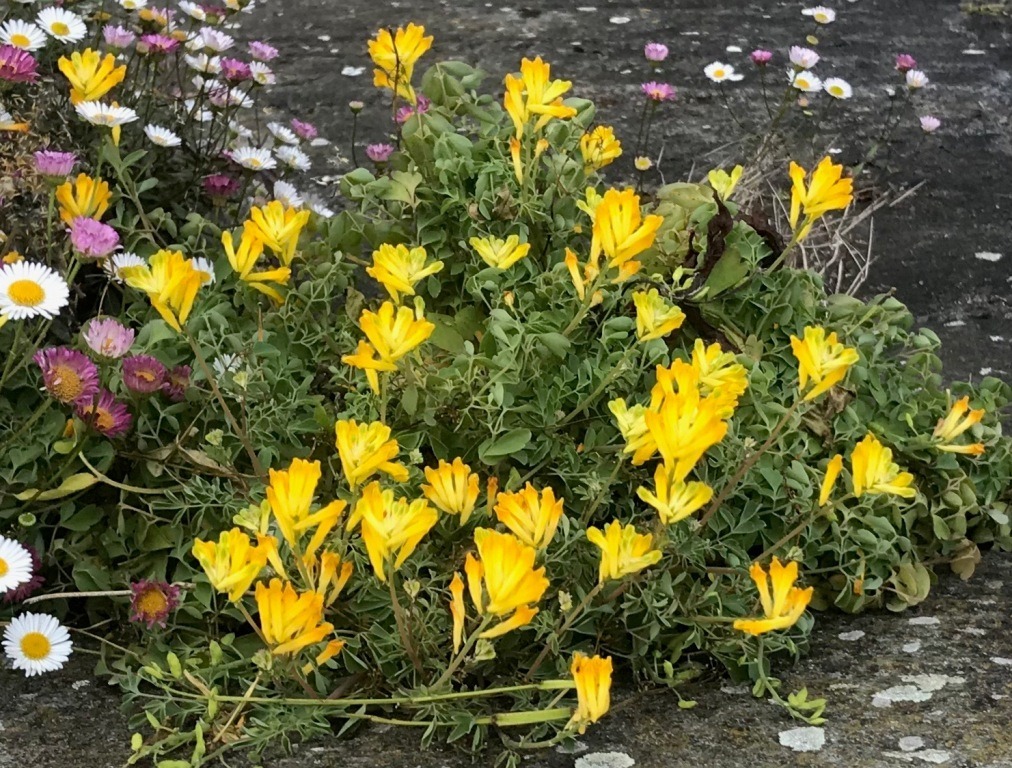In 2009, the Bristol Docks Estate Wildlife Survey and Assessment by Phil Quinn (Ecology and Landuse) and commissioned by Bristol City Council, was published. In this survey, Bathurst Basin was assessed to be a biodiversity hotspot of high value. Friends of Bathurst Basin are keen to support and encourage the rich variety of wildlife in this urban location.
Plants
The Bristol docks wildlife survey found over 425 different plant species in the Floating Harbour and had this to say about Bathurst Basin itself:
…. the habitats of Bathurst Basin support a diverse assemblage of species. Of particular note is the presence of Maidenhair-fern on the dock walls approaching the basin. The eastern walls of the basin in particular, support a visually attractive assemblage of Yellow Corydalis, Mexican Daisy as well as Trailing and Adria Bellflower. Ladies Bedstraw is also present. The non-native, Annual Beardgrass is a notable feature of the western basin.
It also notes this about the wall that runs along the New Cut and connects with the outer walls of Bathurst Basin:
The upper levels of this wall support wetland plants such as skullcap and hemlock water-dropwort and on the mid and lower levels there are saltmarsh species, such as wild celery (Apium graveolens), greater sea-spurrey, sea arrow-grass (Triglochin maritima) and sea couch. These species, in addition to sea aster, common saltmarsh-grass and common scurvygrass are also present in a thin band of saltmarsh vegetation at the base of the wall.
Trees
Planted mature trees line two sides of Bathurst Basin and the quayside in front of the Ostrich. These are mainly Norway Maples (Acer Platinoides) and Common Ash (Fraxinus Excelsior).

Use this link for details of the many plants that have been spotted around Bathurst Basin.
Birds
With the calm water of Bathurst Basin, the rapid tidal flow of the New Cut behind and the gardens and green spaces of the residential areas – particularly around Merchants Landing – the area has a wide variety of bird life. Some of these are noted below. If you have others to add to the list, or photos to share, please let us know by emailing info@fobb.org.uk or posting on our Facebook page.

Blackbird
Blackcap
Black Headed Gull
Blue Tit
Buzzard
Canada Goose
Chaffinch
Collared Dove
Cormorant
Crow
Dunnock
Fieldfare
Goldcrest
Goldfinch
Great Tit
Greenfinch
Grey Wagtail
Heron
Herring Gull
Kingfisher
Lesser Blackback Gull
Long Tailed Tit
Magpie
Mallard
Moorhen
Peregrine Falcon
Pied Wagtail
Pigeon
Robin
Sparrow
Sparrow Hawk
Starling
Swan
Tufted Duck
Wood Pigeon
Wren
Animals
Otters
Otters, one of the best-loved creatures on our waterways, have been seen in Bristol’s Floating Harbour and are probably one of the most urban populations of otter in the country. Nature officers at the city council first became aware of them in 2010 when they discovered otter droppings. They then commissioned a survey including placing a hidden camera, which has confirmed that otters are indeed living in and around the floating harbour.
More than one member of Friends of Bristol Basin has spotted otters in the Basin itself.
Bats
In the Bristol docks wildlife survey, the surveyors had extensive bat survey experience and any evidence or potential for bats was recorded. The survey notes that the Marchioness Shed, just outside the south-west corner of Bathurst Basin has potential for bats.
There are certainly plenty of bats in Bristol and the surrounding area. The Avon Bat Group in an article in Bristol Magazine stated that:
16 out of the 17 species resident in the UK can be found in the old Avon area, including the city itself.
The most common Bristolian bats are the thumb-sized pipistrelles.
Fish
Bristol City Council lists Bathurst Basin quayside as one of the places in the Floating Harbour where fishing is allowed. The Council stresses that all fish must be returned to the water unharmed.
The Floating Harbour contains a rich diversity of fish, both freshwater and estuarine species, according to the 2009 survey. Anglers at Bathurst Basin have told us they catch bream, carp, roach and perch.

